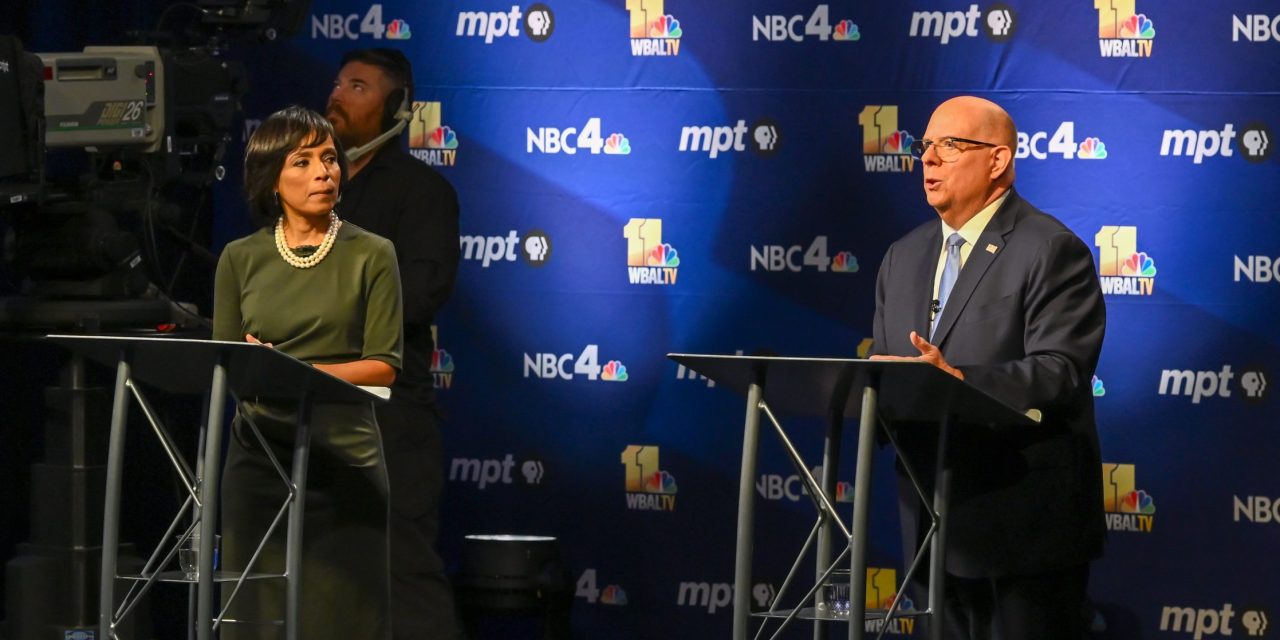By SHAELA FOSTER
Maryland Senate candidate Angela Alsobrooks spent 124% more on radio advertising than opponent Larry Hogan between March and October of this year, according to a Capital News Service analysis of data from the Federal Communications Commission.
While both candidates have employed radio ads to broadcast their message to Marylanders as they compete for the Maryland Senate seat following the retirement of democratic senator Ben Cardin, Alsobrooks has spent considerably more.
From March 1 to Oct. 4, the candidates have advertised on a combined 18 stations across Maryland. Alsobrooks spent over $220,000 on these stations while Hogan spent just $52,000.
In a recent poll taken by the Institute of Politics at UMBC, Alsobrooks is ahead of Hogan by nine percentage points. 48% of likely voters said they would vote for Alsobrooks while 39% said they would vote for Hogan.
The poll was taken Sept. 23 – 28 and surveyed 1,003 Maryland adults.
“We are making sure Angela’s message is heard across mediums, including radio,” said Meredith Happy, Angela Alsobrooks press secretary in an email statement. “People get their information in many different ways, and it’s critical that we ensure Marylanders are hearing about Angela’s incredible record, her vision for the future, and the stakes of this race.”
With the decline of printed newspapers, radio stations offer a “highly segmented audience” said Tom Hollihan, professor in the Annenberg School for Communication and Journalism at the University of Southern California.
“Often the radio market is segmented in such a way that I can pinpoint which voters I’m reaching for every dollar spent,” he said.
He compares this to television advertising where people pay for viewers who potentially can’t vote in their area. With radio advertising, it’s cheaper and politicians can specifically target certain voters, he said.
Hogan advertised on six AM stations where Alsobrooks did not air messages, according to the CNS analysis, accounting for about 650 minutes of airtime for Hogan. Alsobrooks ads aired on five stations where Hogan didn’t advertise, including 460 minutes on WMMJ, an urban adult-focused station.
“From Maryland cities to rural communities, working Marylanders spend a lot of time behind the wheel,” said Blake Kernen, Larry Hogan’s campaign spokesperson via text message. “Local radio is a great way to keep diverse voters from across the state informed.”
Alsobrooks and Hogan’s advertisements only appeared together on seven stations, three of which both candidates shared even amounts of broadcast time.
Over the eight months on the 18 total stations, Alsobrooks advertisements took up over 3,000 minutes of time while Hogan’s took up just under 750 minutes.
Both candidates aired campaign messages on iHeart radio stations, a major radio broadcast organization. iHeart radio offered both candidates the chance to record two free 15-second advertisements that would be broadcast over four of their stations, WCAO-AM, WPOC-FM, WQSR-FM and WXFT-FM.
These ads were aimed at encouraging Marylanders to “register to vote” and “get out to vote.” In August, Hogan utilized this free ad space, encouraging listeners to vote. Alsobrooks used the free space as well but supplemented it with other ads she purchased across stations not affiliated with iHeart radio, spending over $34,000 in August.
According to Happy, the political and government team at iHeart radio created the “register to vote” series as a way to boost involvement in the upcoming election.
This initiative is something Happy said Alsobrooks is grateful for because she believes “voting is not only our right – but also our duty.”
Each candidate purchased ad space during the early morning drive, 6 a.m. to 10 a.m., and the evening drive, 3 p.m. to 7 p.m., both prime time for people traveling to and from work and school.
“If I’m listening to something in the car on the way to work, it’s more likely to impact my water cooler conversations with coworkers,” Hollihan said.
Alsobrooks campaign said it’s important to reach voters where they are, according to Happy, so voters can hear or see Alsobrooks’ vision for the future wherever they consume media.
Alsobrooks and Hogan’s messages reached similar audiences, according to the analysis. Out of the 18 stations, the most common genres each station broadcasted were news, religious, and urban adult contemporary music.
While capturing the attention of radio listeners is important for candidates, Hollihan also spoke about what he called the “second-order media effects” coming into play.
“It’s not just the exposure to the media, it’s the exposure to a friend or colleague who listened to that as well,” he said.







Recent Comments